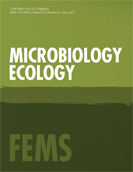Recent studies have focused on linking marine microbial communities with environmental factors, yet relatively little is known about the drivers of microbial community patterns across the complex gradients from the nearshore to open ocean. Here, we examine microbial dynamics in 15 five‐station transects beginning at the estuarine Piver’s Island Coastal Observatory (PICO) time‐series site and continuing 87 km across the continental shelf to the oligotrophic waters of the Sargasso Sea. 16S rRNA gene libraries reveal strong clustering by sampling site with distinct nearshore, continental shelf, and offshore oceanic communities. Water temperature and distance from shore (which serves as a proxy for gradients in factors such as productivity, terrestrial input, and nutrients) both most influence community composition. However, at the phylotype level, modeling shows the distribution of some taxa is linked to temperature, others to distance from shore and some by both factors, highlighting that taxa with distinct environmental preferences underlie apparent clustering by station. Thus, continental margins contain microbial communities that are distinct from those of either the nearshore or offshore environments and contain mixtures of phylotypes with nearshore or offshore preferences rather than those unique to the shelf environment.
AUTHOR
Zackary Johnson
PI Johnson Lab
68 posts
You may also like
Bioenergy Carbon Capture and Storage (BECCS) has been proposed to reduce atmospheric CO2 concentrations, but concerns remain about competition for arable land […]
Thraustochytrids are unicellular fungi-like (heterotrophic) marine protists and have long been considered to play an important role in the biogeochemical cycles of […]
Marine aggregates play a critical role in the biological pump, both as a dominant component of carbon flux and as hotspots for […]
Prochlorococcus, the smallest and most abundant phytoplankter in the ocean, is highly sensitive to hydrogen peroxide (HOOH), and co-occurring heterotrophs such as […]



